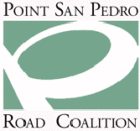John A. McNear bought San Pedro Point in 1868. He had planned to open a shipping terminal there and started to build a railroad, but his financial backing was lost in the San Francisco Fire of 1906. He did, however, build San Pedro Road, which he sold to the County in 1894 for about $150.
San Pedro Road ran from San Rafael to the tip of what became known as McNear Point. An extension ran north and west to Santa Venetia. The tip end was renamed Cantera Way (Cantera is Spanish for quarry).
The County Road (or San Pedro Road) was paved in 1934. From then on, chuck holes were patched whenever our County Supervisor was up for reelection.
Upon leaving San Rafael, Third Street became The Embarcadero, by Lowrie’s Yacht Harbor. Then the road crossed marsh on both sides to Marin Yacht Club. Then there was marsh again until the road started up Townes Hill. Most, but not all, of the nine hole golf links on the north was higher. On the east side of Townes Hill was Camille Mello’s dairy ranch, where Loch Lomond is now. At the south end of Townes Hill is Lucky Point, or as it became known, Paganini Point. Mr. Paganini was the printer for A. P. Giannini’s Bank of Italy. That point is now called San Pedro Cove.
Between Lucky Point and Chicken Point was open water on the south side of the road and marsh on the north.On the north side of the road from Chicken Point is an old subdivision called Bayside Acres.
Upon leaving San Rafael, the city limits reappear three times. It seems that the County was more stringent than the City of San Rafael on building codes. For example, the County required more elevation above sea level and more setback from the road. So developers swooped out into San Rafael Bay and came ashore at Harbor Estates, the marsh across the road from the Golf Tract, Loch Lomond, and at Glenwood and Peacock Gap.
Peacock Gap Subdivision, by the way, got named because the developer liked the name of the gap in the hills where the Peacock family had lived. The State Park Rangers now live there.
There was a big stink when San Pedro Road was widened to four lanes along the Golf Tract. The south side, inside city limits, had insufficient setback while the north side had ample. The powers that be, unlike Solomon and the baby, actually did split the setback, much to the chagrin of those on the north.
The people in Loch Lomond want to “restore the marsh”. What they mean is the Chicken Point marsh, not the marsh where Bonnie Banks Way is now.
When San Pedro Road was widened to four lanes in Peacock Gap, the seawall was raised. The people who lived along Lagoon Road complained that it blocked their view of the bay, so the seawall was lowered. Sure enough, a couple of years later there was a storm at high tide and some of their homes got flooded.
Harbor Estates was developed in 1956. The marsh underneath was filled with mud dredged from San Rafael Canal. The Country Club houses around the golf links were built in the early 1930’s. The houses within the golf links were built in the late 1940’s. Loch Lomond and its yacht harbor were developed in 1956. The marsh and bay were filled with dirt from higher elevation to the north. Glenwood was developed in 1957 and Peacock Gap was developed in 1959. Again, the marshes were filled with dirt from higher elevation.
San Pedro School, just east of Riviera Drive, was built about 1904 by McNear Brickyard. It served children of brickyard and dairy employees, China Camp, Chicken Point, and westward to Townes Hill. It closed about 1950 and children were bused to San Rafael. It was rumored that the bus cost more than the school (believable because the McNears subsidized the school) and the bus driver cost more than the teacher (incredible). St. Sylvester’s Catholic Church now uses the site. Several years later, San Pedro School reemerged just east of Townes Hill.



